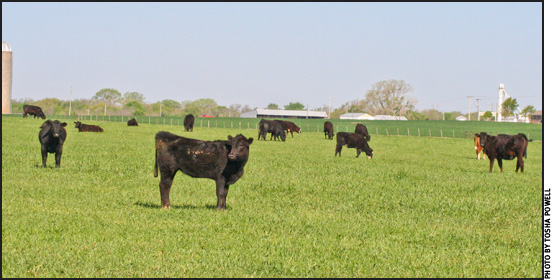
Stocker Market
Wheat pasture demand and limited feeder supplies support stocker prices.
Calf prices in Oklahoma jumped as much as $10 per hundredweight (cwt.) the second week of October, with stronger stocker demand and limited supplies both serving as contributing factors. Feeder-cattle auction volumes in Oklahoma are down 26% over the last six weeks compared to last year. A year ago, fall stocker-calf prices increased counter-seasonally into early December. Conditions are right for similar support to stocker-calf prices this fall. However, given that calf prices are already at high levels and the corn price is sharply higher this year, stocker prices may move up only a bit more or hold mostly steady near current levels.
Last weekend, some parts of Oklahoma received significant rain that will solidify stocker demand in some areas. Rain fell in a swath from central into the northeastern part of the state and across much of the southeast region. Most of the wheat is planted, and some areas may have grazeable wheat by early to mid-November. However, the north-central, northwest and southwest areas received little rain and remain critically dry. Variable moisture conditions across the state mean that wheat stocker demand will likely be spread out across the next few weeks as wheat pasture develops at different rates.
The latest trade data for August reveal another reason for tighter feeder-cattle supplies. Imports of Mexican feeder cattle through July were running more than 30% higher than last year. Mexican cattle imports in August were down more than 50% from last year. However, the 2011 August total was high due to large Chihuahua exports ahead of a change in health status that has since restricted imports from that state. Nevertheless, the August 2012 import total was down (perhaps down 10% from a more normal August 2011 total), suggesting that the large import volumes may be over. The weekly preliminary data for September indicates that Mexican cattle imports will be down even more sharply. Decreased imports the remainder of the year may offset the increases in the first seven months of 2012 and hold the annual import total to no more than last year. Mexican cattle imports in 2013 are expected to be sharply lower than recent years.
Cow-calf producers are seeing the expected impacts of the tight cattle supply situation. Calf prices are currently $20-$25 per cwt. higher than this same time last year. While calf prices are not likely to increase in the next 4-6 weeks as much as last year, they also are not likely to drop.
Cull cow prices are currently $10-$12 per cwt. higher than a year ago due to continued strength in hamburger markets and decreased cow slaughter. Total cow slaughter is down 4.8% for the year to date while beef-cow slaughter is down 13% year over year. In Oklahoma, auction volumes for cows and bulls are down 68% for the last six weeks compared to a year ago. Seasonal pressure on cull cow prices could build over the next month but is expected to be less than usual this year.
Higher corn prices this year are tempering feeder-cattle demand and bigger questions remain about domestic and export beef demand, but tight feeder-cattle supplies will continue to dominate the cow-calf and stocker sectors, keeping calf and feeder prices very high.
Editor's Note: This article is reprinted with permission from the Cow-Calf Corner newsletter provided by Oklahoma Cooperative Extension Service.








